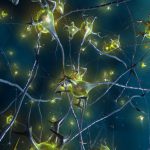“Three pounds of nerve tissue underneath the skull are capable of perceiving, thinking, and acting with a finesse that cannot be matched by any computer.”
 It isn’t like we haven’t tried to match it. Computer “intelligence” is modeled after the brain, or at least the workings of the brain as we know it. Without a doubt, development in the field of computer technology and artificial intelligence has been impressive. The thing is, there is a lot we don’t know. And it is what we don’t know that keeps us searching to learn more.
It isn’t like we haven’t tried to match it. Computer “intelligence” is modeled after the brain, or at least the workings of the brain as we know it. Without a doubt, development in the field of computer technology and artificial intelligence has been impressive. The thing is, there is a lot we don’t know. And it is what we don’t know that keeps us searching to learn more.
Terry Sejnowski and Tobi Delbruck recently wrote an article on this in Scientific American. They are researching how the brain uses its extensive signaling system to choose and use information. In their research, Sejnowski and Delbruck are discovering how the brain efficiently utilizes brain spike timing to quickly and efficiently “encode” and use information that it considers important. 
“The brain achieves this feat of cognition, in part, by carefully timing the signals that flash across the trillions of connections that link billions of brain cells.” Neuroscientists have become particularly interested in the brain’s rapid transport ability referred to as spikes, defined as “millisecond sharp rises in voltage” that communicate “through and between neurons” within massive networks in cells. While this is impressive enough, it’s the coordinated timing of these spikes that is crucial to effectively and successfully accomplish each “task.”
Researchers have found that synchronized spikes, voltage sent almost at the same time to a specified location, create a stronger signal and emphasize the importance of an “event.” These spikes, each of which may  be carrying unique information about a visual object or event, together produce the “picture,” or at least our perception of the picture or object. Scientists believe that this synchronization of spikes, which send information toward a particular “receiving neuron” within a cell, is significant in forming long-term memory. Could it also be that a group of rapid voltage signals zapping a designated area of the brain create those “light bulb” moments we sometimes have?
be carrying unique information about a visual object or event, together produce the “picture,” or at least our perception of the picture or object. Scientists believe that this synchronization of spikes, which send information toward a particular “receiving neuron” within a cell, is significant in forming long-term memory. Could it also be that a group of rapid voltage signals zapping a designated area of the brain create those “light bulb” moments we sometimes have?
Of course, there is much more research necessary before anyone will sufficiently understand the intricacies of exactly how the brain knows when to send rapid electrical impulses to the right place at the right time, as well as the ability to decipher neuron communication utilizing synchronous spikes. But scientists are getting closer. In a somewhat circular irony, computers, whose complexities are emulated by our known knowledge of the brain, have enabled further research into the actions and reactions of neurons and spike timing through computer modeling of the nervous system related to brain function. Since much of Sejnowski and Delbruck’s research has involved timing in regard to the “visual system,” we can look forward to faster and more efficient video abilities in the future, as research is well underway concerning how to implement “spike timing” into video production.
Sejnowski and Delbruck know that their findings, and the research of their colleagues, as they continue to explore the brain’s code system, will eventually change the way computers are built and how they process information. They also feel that it will give us a better understanding of human behavior, noting autism as one example. Ultimately, it will redefine the “science” of how we learn.

Just how and how soon will this and future neuro-research change our reality? Intriguing questions…I’m sure the possibilities roaming around in our brain cells are waiting for that neuronic “spike” moment. Time, or timing, will tell.
It’s About Time
9 October, 2012 by Anne • learning, Science • Tags: brain, learning, science • 0 Comments
“Three pounds of nerve tissue underneath the skull are capable of perceiving, thinking, and acting with a finesse that cannot be matched by any computer.”
Terry Sejnowski and Tobi Delbruck recently wrote an article on this in Scientific American. They are researching how the brain uses its extensive signaling system to choose and use information. In their research, Sejnowski and Delbruck are discovering how the brain efficiently utilizes brain spike timing to quickly and efficiently “encode” and use information that it considers important.
“The brain achieves this feat of cognition, in part, by carefully timing the signals that flash across the trillions of connections that link billions of brain cells.” Neuroscientists have become particularly interested in the brain’s rapid transport ability referred to as spikes, defined as “millisecond sharp rises in voltage” that communicate “through and between neurons” within massive networks in cells. While this is impressive enough, it’s the coordinated timing of these spikes that is crucial to effectively and successfully accomplish each “task.”
Researchers have found that synchronized spikes, voltage sent almost at the same time to a specified location, create a stronger signal and emphasize the importance of an “event.” These spikes, each of which may be carrying unique information about a visual object or event, together produce the “picture,” or at least our perception of the picture or object. Scientists believe that this synchronization of spikes, which send information toward a particular “receiving neuron” within a cell, is significant in forming long-term memory. Could it also be that a group of rapid voltage signals zapping a designated area of the brain create those “light bulb” moments we sometimes have?
be carrying unique information about a visual object or event, together produce the “picture,” or at least our perception of the picture or object. Scientists believe that this synchronization of spikes, which send information toward a particular “receiving neuron” within a cell, is significant in forming long-term memory. Could it also be that a group of rapid voltage signals zapping a designated area of the brain create those “light bulb” moments we sometimes have?
Of course, there is much more research necessary before anyone will sufficiently understand the intricacies of exactly how the brain knows when to send rapid electrical impulses to the right place at the right time, as well as the ability to decipher neuron communication utilizing synchronous spikes. But scientists are getting closer. In a somewhat circular irony, computers, whose complexities are emulated by our known knowledge of the brain, have enabled further research into the actions and reactions of neurons and spike timing through computer modeling of the nervous system related to brain function. Since much of Sejnowski and Delbruck’s research has involved timing in regard to the “visual system,” we can look forward to faster and more efficient video abilities in the future, as research is well underway concerning how to implement “spike timing” into video production.
Sejnowski and Delbruck know that their findings, and the research of their colleagues, as they continue to explore the brain’s code system, will eventually change the way computers are built and how they process information. They also feel that it will give us a better understanding of human behavior, noting autism as one example. Ultimately, it will redefine the “science” of how we learn.
Just how and how soon will this and future neuro-research change our reality? Intriguing questions…I’m sure the possibilities roaming around in our brain cells are waiting for that neuronic “spike” moment. Time, or timing, will tell.